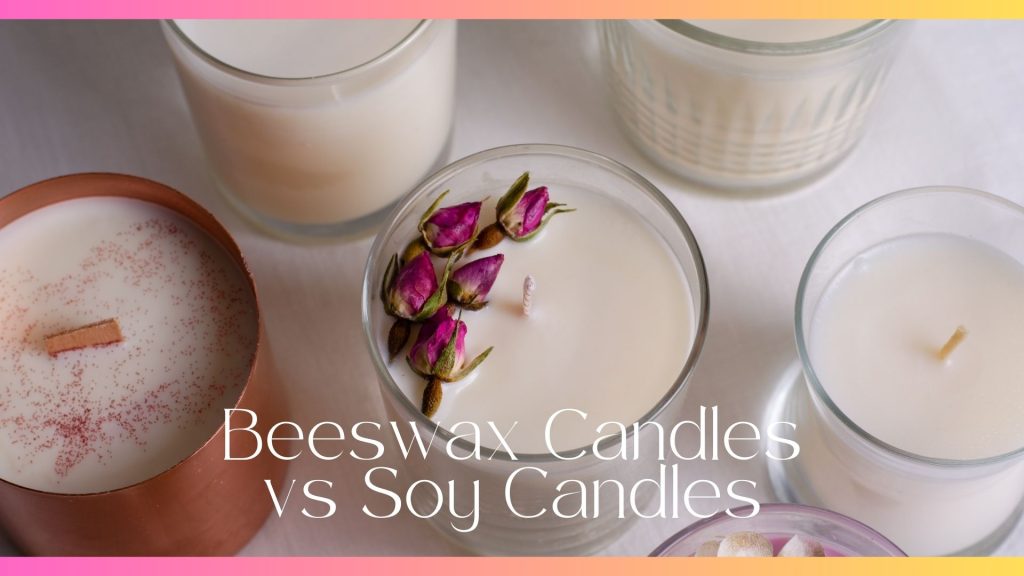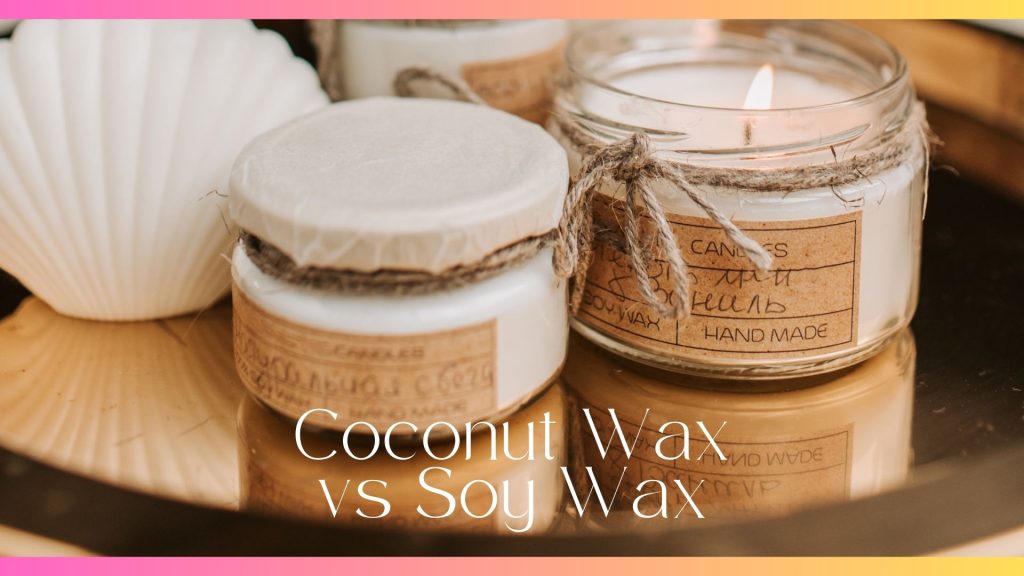Wondering to yourself – is coconut wax good for candles and candle-making? Here’s everything you should know before deciding if it’s the right one for you.
When making candles, you have a wide range of ingredient options to choose from. What works for one person may not work for another and vice versa.
In this article, I’ll discuss the benefits of coconut wax and what makes them a good wax option for candle-making.
Disclaimer: This post may contain affiliate links. This means I may earn a small commission (at no cost to you) if you sign up for a program or make a purchase using my link!
Related Posts:
- Soy Candles vs Coconut Candles for Candle-making
- How To Make Coconut Wax Candles with Essential Oils
- How Long Do Coconut Wax Candles Need To Cure?
What is Coconut Wax?
Coconut wax is a type of wax derived from the meat of coconuts. It is known for its stronger ability to hold and release fragrance when used for making scented candles. This is in comparison to candles made of waxes like paraffin and soy.
Although it’s relatively new in the market compared to other two, it’s emerging as a sustainable alternative for candle-making as it is biodegradable and burns cleanly.
Unsure how coconut wax is made? They’re created by hydrogenating coconut oil – a process where liquid oil is converted into a solid wax. The solid wax is then used to make candles and this results in a smooth, creamy wax that burns evenly.
When deciding on whether coconut wax is good for candles, we’ll need to consider its benefits as well as pros and cons, in comparison to other waxes available in the market.
4 Benefits of Using Coconut Wax for Candles
Using coconut wax for candles comes with a host of benefits, ranging from environmental to health to performance-related advantages.
1. Environmental Impact
Coconut wax is celebrated for its minimal environmental footprint. Firstly, coconut is a renewable resource and they grow in abundance, without requiring extensive land use or pesticide application. This may not be the case for some other crops.
Since coconut waxes are natural, it is biodegradable unlike other synthetic waxes. This means it will break down naturally over time, reducing its impact on landfills and the environment.
2. Health Benefits
Another reason to love coconut wax candles is because coconut wax is non-toxic and burns cleanly, without producing harmful chemicals. It is a safer option for those with respiratory issues or sensitivities to synthetic fragrances.
Coconut wax candles also burns cleanly, producing less soot compared to paraffin wax. Your candle jars can stay cleaner and you get to maintain a good indoor air quality while burning your candles.
Is Coconut Wax Good for Skin?
Some may question if coconut wax is good for skin. Since coconut oil has excellent moisturizing properties, coconut wax can be beneficial for dry and sensitive skin.
It is also non-toxic, gentle on skin, as well as free from harmful chemicals and synthetic additives. Of course, with every product, it’s best to read manufacturer’s guidelines and application method to know if the specific coconut wax can be used on skin.
3. Performance
While it may be tempting to go for other kind of waxes due to cost, it might make sense to choose coconut waxes if you’re prioritizing your candle’s burn time. Coconut waxes generally have an excellent scent throw, which means it can disperse fragrance well throughout a room.
If you’re planning to make scented candles using coconut wax, it’s great to know that you can enjoy your favorite aromas for longer. This unique property is paired with its long burn time – resulting in your longer-lasting candles for your enjoyment.
Since coconut wax candles burn cleanly, there’s also less chances for the occurrence of tunneling (something you would want to avoid!).
4. Appearance
Some may purchase candles for their fragrances, but a huge portion of us might be purchasing them for their aesthetic appearance.
If you’re a candle-maker, it’s important to know how your candles will look like in the end, including its texture. Coconut wax candles has a smooth, creamy appearance that makes your candles look a little more luxurious.
Planning to add colors to your candles? Coconut wax holds color well, allowing for a vibrant, beautiful candle creation if you want them to be.
Pros and Cons of Coconut Wax Candles
The advantages of coconut wax candles:
- Environmentally Friendly: Coconut wax is biodegradable and made from a renewable resource, reducing its environmental impact.
- Longer Burn Time: Coconut wax candles burn longer and more evenly than many other types of candles.
- Better Scent Throw: The wax holds fragrance well, providing a strong and lasting scent.
The disadvantages of coconut wax candles:
- Cost: Coconut wax is often more expensive than other types of wax.
- Availability: Coconut wax candles are less common and may be harder to find compared to paraffin or soy wax candles.
Comparing Coconut Wax to Other Wax Types
How does coconut wax stack up against other popular types of wax? Here’s a comparison table for coconut wax, paraffin wax, soy wax, and beeswax used in candle making.
| Feature | Coconut Wax | Paraffin Wax | Soy Wax | Beeswax |
|---|---|---|---|---|
| Source | Coconut oil | Petroleum by-product | Soybean oil | Bees and honey production |
| Burn Time | Long burn time | Moderate burn time | Long burn time | Longest burn time |
| Soot Production | Very low | High | Low | Very low |
| Scent Throw | Excellent | Excellent | Good | Moderate |
| Eco-Friendliness | Highly eco-friendly | Not eco-friendly | Eco-friendly | Highly eco-friendly |
| Cost | Expensive | Cheap | Moderate | Expensive |
| Color | White to off-white | White to translucent | White to pale | Golden yellow |
| Ease of Use | Easy to work with | Easy to work with | Requires some experience | Harder to work with |
| Melting Point | Low (around 120°F) | High (around 120-160°F) | Low to moderate (around 120°F) | High (around 144-147°F) |
| Renewability | Renewable | Non-renewable | Renewable | Renewable |
| Health Impacts | Non-toxic | Can release harmful chemicals | Non-toxic | Non-toxic |
| Other Notes | Smooth, creamy finish; natural sheen | Versatile, holds color and scent well | Can be mixed with other waxes | Harder texture; natural honey scent |
Coconut Wax vs. Soy Wax for Candle-making
Here’s a table comparing the benefits of using coconut wax versus soy wax for candle making.
| Feature | Coconut Wax | Soy Wax |
|---|---|---|
| Source | Coconut oil | Soybean oil |
| Eco-Friendliness | Highly eco-friendly; biodegradable | Eco-friendly; biodegradable |
| Renewability | Highly renewable | Renewable |
| Burn Time | Long burn time | Long burn time |
| Soot Production | Very low | Low |
| Scent Throw | Excellent scent throw | Good scent throw |
| Color | White to off-white | White to pale |
| Texture | Smooth, creamy texture | Smooth texture |
| Melting Point | Low (around 120°F) | Low to moderate (around 120°F) |
| Performance | Burns evenly, reducing tunneling | Burns evenly, reducing tunneling |
| Non-Toxic | Non-toxic; burns cleanly | Non-toxic; burns cleanly |
| Health Benefits | Produces very little soot; safer for respiratory issues | Produces little soot; safer for respiratory issues |
| Cost | More expensive | Moderately priced |
| Availability | Less widely available | Widely available |
| Versatility | Often used for luxury and specialty candles | Commonly used for a variety of candles |
| Aesthetic Appeal | Holds color well; adds a touch of luxury | Holds color well; has a natural, matte finish |
| Ease of Use | Easy to work with | Requires some experience |
In summary, both coconut and soy wax are non-toxic and safer alternatives to paraffin wax, which can release harmful chemicals when burned.
When it comes to candle-making, coconut wax offers better scent throw and longer burn time. Soy wax candles may not hold scent or fragrances as well as coconut wax candles.
Although both waxes are made from natural ingredients, coconut wax is considered more sustainable as soy wax may involve more intensive agricultural practices.
For this reason, some candle-makers may prefer making coconut soy candles where both coconut wax and soy wax are used to make blend candles. Combining the two enhances the candle’s burn time, scent throw and makes the candle more stable against changes in temperature.
How to Use Coconut Wax in Candle-making
Ready to start making your own coconut wax candles? Here’s a general guideline you can follow!
Essential Equipment
To get started, you’ll need some basic candle-making equipment:
- Coconut wax
- Candle wicks
- A double boiler or wax melter
- Thermometer
- Fragrance oils
- Candle containers
- Stirring sticks
- Digital scale
Step-by-Step Candle Making Process
- Melt the Wax: Using a double boiler or wax melter, heat your coconut wax to around 180°F (82°C).
- Prepare the Containers: While the wax is melting, place your wicks in the candle containers. You should also measure the fragrance oil to be 6%-10% of wax amount used.
- Add Fragrance: Once the wax reaches 180°F, remove it from heat and let it cool to around 160°F (71°C). Add your fragrance oil and stir well.
- Pour the Wax: Carefully pour the wax into your prepared containers, ensuring the wick remains centered.
- Cool and Cure: Allow the candles to cool and cure for at least 24 hours before trimming the wicks and lighting your candles.
When storing your candles, place them in a cool, dry place away from direct sunlight. This will prevent the wax from melting or becoming discolored. Before each use it’s best to trim the wick to about ¼ inch – this helps the candle burn evenly and prevents soot buildup.
Bottom Line
Still wondering if coconut wax is good for candles and candle-making? You don’t have to look any further!
Coconut wax candles have its own unique benefits compared to other kinds of waxes. It’s gaining popularity among eco-conscious consumers and even among candle-makers who prioritizes candle quality.
Whether you’re making candles for personal use or to sell, coconut wax is definitely an option to consider!
Frequently Asked Questions (FAQs)
While coconut wax offers many benefits, there are a few potential drawbacks. It tends to be more expensive than other waxes like soy or paraffin, which can be a consideration for budget-conscious consumers. Additionally, coconut wax candles may have a softer texture, making them more prone to dents or marks if not handled carefully. Availability can also be limited compared to more mainstream waxes.
Whether coconut wax is better than soy wax depends on your priorities. Coconut wax generally has a stronger scent throw and longer burn time compared to soy wax. It also has a smooth and creamy texture, which enhances the candle’s appearance. However, coconut wax is usually more expensive than soy wax and may not be as widely available. Soy wax, on the other hand, is known for its clean burn and affordability, making it a popular choice among candle makers and consumers alike.
Coconut wax candles offer several advantages. They have a strong and pleasant scent throw, filling a room with fragrance effectively. The wax burns slowly and evenly, resulting in a longer burn time compared to many other types of candles. Coconut wax is also derived from a renewable resource, making it more environmentally friendly. Additionally, candles made from coconut wax often have a smooth and appealing appearance due to the wax’s natural texture. Overall, coconut wax candles provide a luxurious and high-quality candle experience.
The healthiest candle wax options include soy wax, beeswax, and coconut wax. These waxes are natural and derived from renewable resources, making them safer alternatives to paraffin wax, which can release harmful chemicals when burned. Beeswax is known for its natural air-purifying properties, while soy and coconut waxes offer clean burns with minimal soot. Choosing candles made from these waxes can help reduce indoor air pollution and potential health risks associated with synthetic additives or petroleum-derived waxes.


